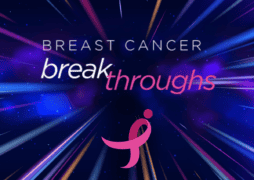ER+ (estrogen receptor positive) breast cancer accounts for approximately 70-80 percent of all breast cancers in the US. And while there are treatments for this subtype of breast cancer, many of these cancers eventually become resistant to those treatments. The issue of treatment resistance has confounded researchers for years – why does a patient become resistant to treatment? It is a question that Svasti Haricharan, Ph.D, and her lab are working to better understand.
Haricharan is an assistant professor at Sanford Burnham Prebys Medical Discovery Institute. She recently spoke to Susan G. Komen about her work and what she’s learning about treatment resistance.

Q: It is not uncommon to hear patients say their treatment stopped working and they have to start a new treatment. How many people with ER+ breast cancer experience this issue?
A: You have about 20 percent of women who are intrinsically resistant to endocrine therapy (or hormone therapy), which means at the time of their diagnosis, they’re already resistant to the standard of care for ER+ breast cancer. Then another 40 percent will become resistant over the duration of their treatment.
In general, we give patients with ER+ breast cancer endocrine therapy for as long as possible. When they relapse or become resistant to their treatment, we then use as many different targeted therapies as possible to see if any of them will work.
Q: So, resistance sounds like a rather common factor in ER+ breast cancer treatment. What kind of work are you doing to better understand resistance?
A: In our lab, we think there are specific things that happen within the breast tumor cell as it starts its journey to become a cancer that can tell us how this normal cell evolves to become cancer. And during that process, there are many different steps, some of which we think fundamentally change how that tumor cell has evolved and gives it the seeds of resistance to endocrine treatment.
We think if we can find those seeds of resistance right at the time of diagnosis, that could change the treatment landscape from, “We’re going to give you endocrine therapy for 10 years and it will probably work but then you might become resistant,” to “We can give you this alternate combination therapy and maybe you’ll never become resistant. Maybe this will cure you of your disease.”
Q: Essentially you think there are clues at the time of diagnosis, and probably even well before diagnosis, that tell us who is or will become resistant to endocrine therapy?
A: We think the seeds for both kinds of resistance happen early on. And now that we have more sophisticated technologies in terms of doing whole genome sequencing or even transcriptomics (the ability to analyze the activity of genes), we are very capable of finding those really early molecular events even though we’re looking at a cell that has evolved much further past that early event.
The reason I think we’ve had trouble finding these seeds in the past, is that we didn’t have access to as much actual patient tumor data as we do now. Previously, a lot of our discovery screens were done in cell lines or mouse models. And those were great, but fundamentally we were studying what we think can happen in a cell, rather than what actually does happen in a patient cell.
Q: What have you found by studying patient tumor data?
A: If you look at 800 patient tumors you start to see what happens to each patient and if there are any common molecular differences that occurred in all of the tumors. Then you can trace those patterns back and look at cell evolution and find within a cell where the link between estrogen or hormone signaling, and the cell cycle snapped. This is important because we know when the link is snapped, all the therapies we’re using to try to disrupt the estrogen signaling never actually make it to the cell cycle regulation stage, which is needed for the therapy to be effective (kill the tumor).
In other words, if the link is snapped it doesn’t matter how much you bombard the upstream factors (estrogen signaling or hormone signaling), it doesn’t really affect the downstream factors (the tumor).
Q: It sounds like finding those links would help doctors know which therapies to use and could hopefully provide some degree of certainty that the therapy would work.
A: That’s one of the main things my lab works on – trying to find the broken links. And then once you’ve found the broken link, you can actually say, “I know exactly where the link broke. So, if I try to target this tumor a little bit downstream of where that link broke, the treatment is more likely to be effective in stopping the tumor from growing or dividing and spreading.
This is one of the reasons we think, however advanced your tumor is at diagnosis, if you can trace back to all the broken links, we can now map out a plan to empower a clinician to actually, in a very precise and intelligent way, target the things that are downstream of the broken link. If we can do that, then we’re preventing all of these other adverse circumstances that happened through years of therapy that were ineffective because the patient developed resistance.
Q: How is the research you’re doing going to impact patient outcomes, especially for those with ER+ breast cancer who develop resistance?
A: Because we have access to patient data, we don’t have to go blindly forward anymore. You don’t have to keep trying to kill cells on a petri plate, or tumors that are growing in the mouse. We can actually say, “I’m seeing this signaling change happen in my cells on a petri plate when I do this thing. Let me go back to patient tumors and see, ‘Does this happen to patient tumors when we give them the same therapies?’ Because if I’m seeing the association, I know I’m heading down the right path to actually change patient lives.”



